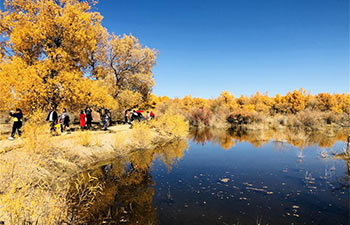
Children stand by the door of the house rebuilt in the old city of Mosul, Iraq, on Oct. 12, 2018. Younis Abu Rajab and his family are the first to return to their house at the badly destroyed al-Qali'at neighborhood in the old city center in Iraq. Abu Rajab rebuilt his two-story house, which looks elegant with its light color painting, amid surrounding rubble, smell of death and fearful darkness at night. (Xinhua/Yasser Jawad)
MOSUL, Iraq, Oct. 13 (Xinhua) -- Younis Abu Rajab and his family are the first to return to their house at the badly destroyed al-Qali'at neighborhood in the old city center in Iraq.
Abu Rajab rebuilt his two-story house, which looks elegant with its light color painting, amid surrounding rubble, smell of death and fearful darkness at night.
About 15 months after liberation from the extremist Islamic State (IS) militant group, Iraq's second largest city of Mosul still lies in ruins and residents are still struggling to rebuild their life.
In the old city center of the western side of Mosul, which witnessed one of the fiercest battles since World War II, the devastation left no building and stone in it, but Abu Rajab's house appears from the right side of the city and defiantly.
"I built the house with my own effort and help from a local organization," said Abu Rajab, a blacksmith who used to own one of the oldest workshops in the blacksmith market in Mosul's old city center.
Although Abu Rajab is deeply in debt and his move seems hasty, the pain and suffering of being displaced for long time pushed him to take his decision.
"I wish my return could bring life back to my neighborhood and encourage many of neighbors to do their best to rebuild their houses," Abu Rajab said.
"This is the start of rebuilding our life here in the abandoned neighborhood, beside buried deaths under the rubble of the neighborhood," he said pointing to his house.
"If they (government) unearth the deaths who are buried under the debris of the houses life would return easily," he added.
Many residents have family members buried under the rubble, but unable to move them.
The extremist IS militants holed up in the narrow alleys of Mosul's old city center and forced the Iraqi forces to make slow progress due to the stiff resistance of IS militants and a large number of roadside bombs and booby-trapped buildings. In addition, IS snipers took positions in the buildings and narrow alleys of heavily-populated neighborhoods, where thousands of civilians were still living under IS rule.
On July 10, 2017, the Iraqi government army recovered the heavily populated city after nearly nine months of fierce fighting and heavy bombardment.
Observers believe that insufficient efforts have been made by the Iraqi authorities since July 2017 to retrieve thousands of bodies buried under debris in Mosul, particularly in the old city of Mosul.
Three months ago, workers retrieved more than 5,200 bodies who were buried under debris of the devastated buildings in the old city center of the western side of Mosul.
Many people expressed their willingness to do anything that may help regain their normal life, despite the lack of money and equipment until the world and the Iraqi government would launch the long-awaited campaigns of reconstruction.
A large part of Iraq's northern province of Nineveh, including its capital Mosul, fell under the IS control in June 2014, when government forces abandoned their weapons and fled, enabling IS militants to take control of parts of Iraq's northern and western regions.















